Veterinary Advice Online - Ferret Sexing.
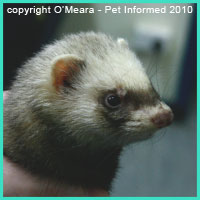 Ferrets are pretty darn easy to sex to be quite honest, even for amateur ferret keepers, making this ferret sexing page somewhat of an unnecessary addition to this website.
Still, for those of you who "just want to be sure", this page on sexing ferrets should make it easy for you to determine the gender of your ferret friends.
Ferrets are pretty darn easy to sex to be quite honest, even for amateur ferret keepers, making this ferret sexing page somewhat of an unnecessary addition to this website.
Still, for those of you who "just want to be sure", this page on sexing ferrets should make it easy for you to determine the gender of your ferret friends.
This page contains everything you, the pet owner, need to know about sexing male (hob or jack) and female (jill) ferrets. Information provided on this ferret sexing page is supported by a number of helpful pictures
and photographs that clearly illustrate how to distinguish the boys from the girls.
Ferret sexing topics are covered in the following order:
1. Some basic dos and do nots when handling and sexing ferrets for the first time.
2. Ferret Sexing - How to tell male ferrets from female ferrets.
3. Female ferrets who come into heat and stay in heat can die - an important health message for all ferret keepers.

WARNING - IN THE INTERESTS OF PROVIDING YOU WITH COMPLETE AND DETAILED INFORMATION, THIS FERRET SEXING PAGE DOES CONTAIN IMAGES AND PHOTOS OF FERRET ANATOMY THAT SENSITIVE READERS MAY POTENTIALLY FIND EXPLICIT.

1. Some basic dos and do nots when handling and sexing ferrets for the first time.
There is not too much that can go wrong when attempting to determine the sex of ferrets, aside from the sexer
getting bitten, however, I will draw your attention to a couple of important ferret-handling dos and do nots, which should
be taken into consideration.
DO:
- Handle your ferret gently and quietly. Ferrets may bite if they are alarmed or hurt by the handler.
- Perform ferret sexing or any ferret examination on the floor or on a very low table (e.g. short coffee table). This way, if the animal struggles or bites and gets away, no injury will occur as a result of the animal falling from a great height.
- Rest ferrets on a clean towel on their backs or rumps (holding them firmly and gently such that they are comfortable, but cannot escape or bite) or hold them cupped in your hands on their backs to examine their genitals. Ferret genitalia is more easily examined when the animal is sitting on its bottom or back. It can
help to have a person hold the ferret for you (handling the head and body), freeing up your hands to hold the back legs
and examine the genitalia. Ferrets are strong and some can be too wriggly and squirmy for one person to sex on their own!
- Exceptionally tricky or bitey ferrets can be wrapped in a towel (loosely wrap the upper, bitey half of the ferret in the towel, leaving the belly and hindlegs free), enabling you to handle the hindlegs and genitals
without getting bitten.
- Wriggly, non-bitey ferrets can be wrapped in a towel, as described above, however this kind of man-handling
is not usually necessary. Nice, but wriggly, ferrets are usually able to be distracted with food or Nutrigel
(a tasty vitamin paste), keeping them still enough for you to examine their bellies and bottoms.
- Where possible, wait until ferrets are over 4-6 weeks of age (weaning age) before trying to determine their gender. This will reduce the risk of the mother ferret rejecting her newborn ferret babies because of your smell.
- If you must handle young pups, do put them back with their mother immediately if they become distressed from handling.
- If you have to handle and sex newborn ferrets, wear disposable gloves (so you don't pass any diseases on to them) and do so in a warm area and for no more than 5 minutes at a time so that they do not get cold and distressed.
- Wear disposable gloves if handling newly-acquired ferrets whose background (history, where they came from and so on) is unknown, particularly if they show any signs of skin sores, hair loss (bald spots), scaly skin, snuffles, respiratory disease, diarrhea or neurological disease or if you already have healthy ferrets at home. Ferrets can carry a range of diseases that are contagious to humans and other ferrets (e.g. mange, mites, ringworm, influenza, distemper and so on) and wearing gloves will help to reduce disease transmission.
DO NOT:
- Handle ferrets roughly. You can hurt them and they can and will bite you.
- Pick ferrets up by their tails or hang them by their tails (they are not mice!). This is cruel and unnecessary.
- Handle newborn ferret pups (pups under 4 weeks of age) if you can avoid it. Mother ferrets (especially new mothers) can become uncertain of their new puppies if you handle them too much and get your human smell all over them. This can potentially lead to the mother ferret rejecting her pups.
- Handle pups if they are still suckling (not yet weaned) and their mother is clearly distressed by you handling them. This can result in bites and rejected puppies.
- Handle newborn puppies (<3 weeks old) for long periods of time. They can become cold away from the nest.
- Hold ferrets loosely or leave them unattended on elevated surfaces. They will dash off a high table or bench top if frightened, leading to severe injury.
- Attempt to expose or pull out the penis of prepubescent male ferrets (hobs under 6 months of age). Such animals are not capable of exposing their penis and attempting to do so forcibly can damage the penis.
 2. Ferret Sexing - How to tell male ferrets (hobs or jacks) from female ferrets (jills).
2. Ferret Sexing - How to tell male ferrets (hobs or jacks) from female ferrets (jills).
The best way to determine the sex of male and female ferrets is to rest the animals on
their backs or rumps on a warm towel or hold them cradled on their backs in your hands and examine their bellies and genitals. Ferret genitalia is more easily examined when the animal is sitting on its bottom or back. It can help to have a person hold the ferret for you (handling the head and body), freeing up your hands to hold the back legs and examine the genitalia. There are several differences that exist between male and female ferrets, even newborn ferrets, which you can look out for when sexing ferrets.
Important note - only keep ferrets on their backs for a short period of time: just long enough for you to determine their sex. Keeping them on their backs too long can be distressing to them and even nice ferrets
might bite you under these conditions.
1. Male ferrets are larger than female ferrets.
The body of male ferrets is generally larger in size and bulk than that of female ferrets (comparing
ferrets of the same age, of course). Males tend to have more body muscle and much larger, wider, rounder heads than females. Females tend to have narrower, daintier heads, with thinner, pointier noses.
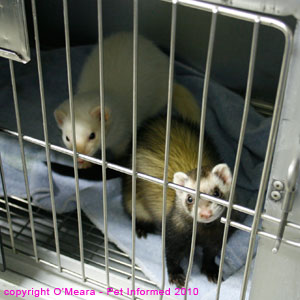
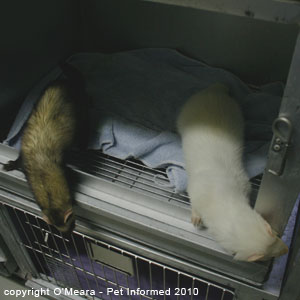
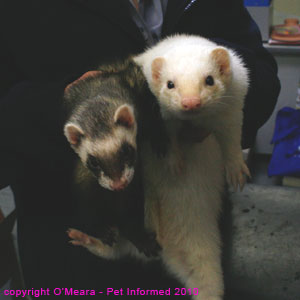 Ferret sexing pictures:
Ferret sexing pictures: These are photos of two young ferrets. Their age is the same. The male ferret
is the larger animal (white fur) with the longer, wider body and bigger head. The smaller, narrower ferret is the female (the animal with the brownish sable "polecat" coloration).
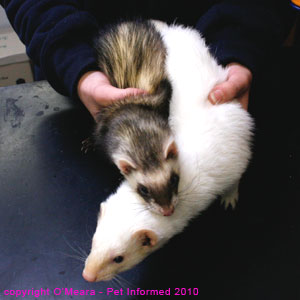
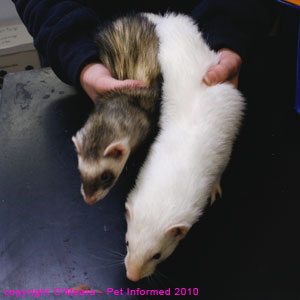
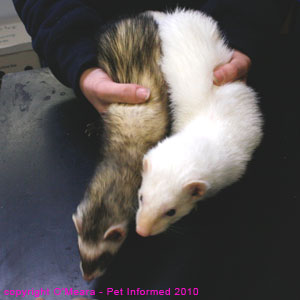
Ferret sexing images: These are photos of two young ferrets. Their age is the same. The male ferret
is the larger animal (white fur) with the longer, wider body and bigger head. The smaller, narrower ferret is the female (the animal with the brownish sable "polecat" colouration).
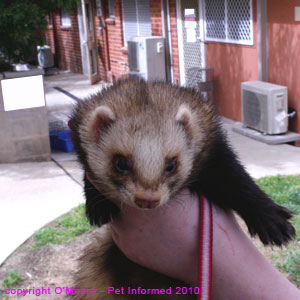
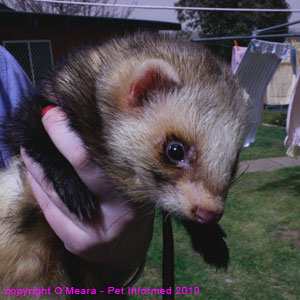
Ferret sexing - male: These are photos of the head of a large entire male ferret. The first photo
is a front-on image showing the broad, round face of the male ferret. The second photo shows
the slightly arched, 'Roman nose' of the male ferret.
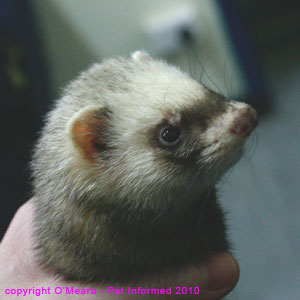
Ferret sexing - female: This is a photograph image of the head of an entire female ferret.
Her head is small and her nose appears 'pointy' and narrow in profile.

2. Male ferrets have a penis in the middle of their belly and two testicles located beneath their anus. Females do not.
This is all pretty self-explanatory.
The belly of the female ferret is smooth, whereas the male ferret has
a small, raised, pointed penis in the middle of its tummy. The penis of the male ferret is easiest to spot when
the ferret is placed on its back. The fur surrounding the male ferret's penis is often stained dark brown or yellow. This staining may be the result of: natural fur colouration, urine residues, moist yeast over-growth and/or licking activities (the ferret licking and grooming the penis region).
The male ferret has a pair of marble-sized testicles contained within a furred scrotal sac located
immediately beneath the anus. These testicles are easily seen when the ferret is placed
on its back.
The female ferret does not have any testicles (obviously). Instead of testicles, the genital opening (vulva) of the female ferret is located in this region just beneath the animal's anus. The vulva of the
female ferret appears as a vertical slit-like opening (the entrance to the vagina). If the ferret
is not in heat, the skin of the vulval opening is flat and flush with the surrounding skin. If the ferret is in heat (estrus),
the skin of the vulval opening swells massively, rising well above the level of the surrounding skin
(the swollen vulval tissue looks like a giant, swollen 'donut' surrounding the vaginal opening).
Note - The male ferret's penis and testicles are most easily seen and photographed when the belly of
the ferret is shaved (e.g. prior to desexing surgery). As a ferret owner, you should not need to shave the animal's
belly to determine its sex (you can usually find the penis by looking through the ferret's belly fur and by feeling the belly skin
with your fingers). I have, however, included pre-surgical images of male and female ferrets with shaved tummies
to more clearly illustrate the differences that exist between the two sexes.
Ferret sexing - Male (hob) ferret pictures:
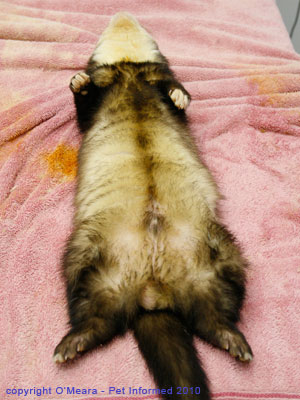
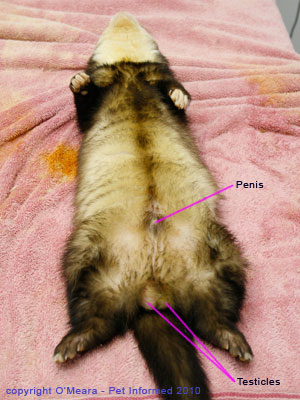
Ferret sexing pictures: This male ferret has been anesthetized ready for neutering surgery. This is a photo taken of him laying on the preparation table just prior to clipping. No fur has
yet been clipped away, but his penis and testicles are clearly evident through the hair.
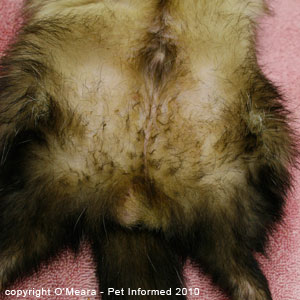
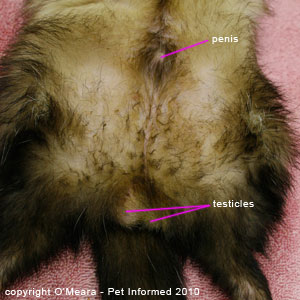
Sexing ferrets images: This male (hob) ferret has been anaesthetised ready for desexing surgery. This is a close-up photo of his belly and genital region taken just prior to clipping. No fur has
yet been clipped away, but the penis and testicles are clearly evident through the hair. The prepuce
(sheath protecting the penis) skin is raised into a small point in the middle of the belly. The fur around this
penis region is colored dark brown (either staining or just the natural color of the fur in this case). The testicles
are marble-sized and contained within a furred scrotal sac located just beneath the animal's anus.
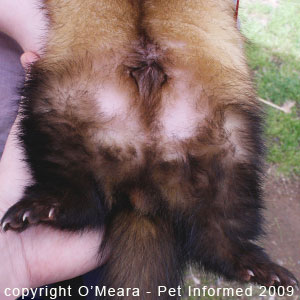
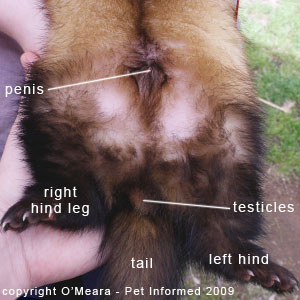
Ferret sexing images: This is a different ferret to the one seen in the images above. This male (hob) ferret was not anaesthetised for this photo - he was a nice boy who was very happy to rest on his back in someone's arms. This is a close-up photo of his belly and genital region. The penis and testes are clearly evident through the hair. The prepuce (sheath protecting the penis) skin is raised into a small point in the centre of the belly. The fur around this
penis region is coloured dark brown (either staining or just the natural colour of the fur in this case). The testicles
are marble-sized and contained within a furred scrotal sac located just beneath the animal's anus.
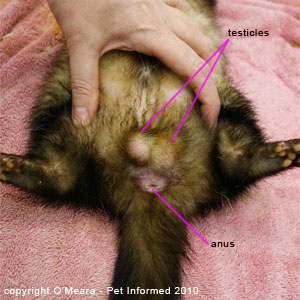
Sexing ferrets photos: In this picture, the ferret's testicles have been raised to show their close
proximity to the animal's anus.
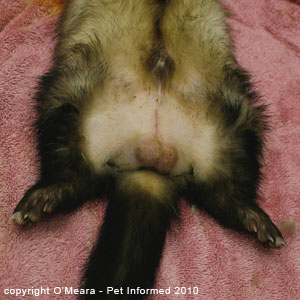
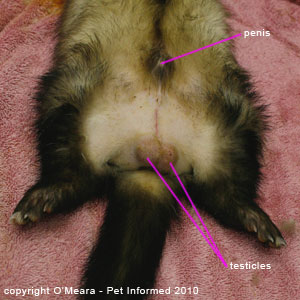
Ferret sexing pics: This male (hob) ferret has been anaesthetised ready for desexing surgery. This is a photo of his belly and genital region taken just after clipping. The fur has
been clipped away from his scrotum (i.e. the skin covering the two testicles), but not his penis. The two round balls that are the testicles are now clearly evident within their scrotal skin covering. The testicles are marble-sized and contained within a scrotal sac located just beneath the animal's anus.
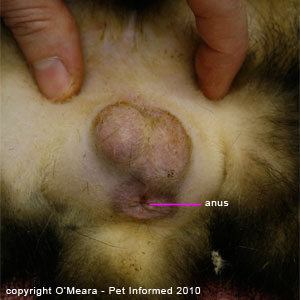
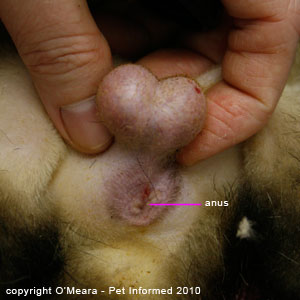
Ferret sexing images: This is a close-up photo of the above ferret's genital region, taken just after clipping. The fur has been clipped away from the scrotum (i.e. the skin covering the two testicles)
and the two round balls that are the testicles are now clearly evident within their scrotal skin covering. The testicles are marble-sized and contained within a scrotal sac located just beneath the animal's anus.
The second ferret sexing image shows the testicles being elevated within their scrotal covering. The image gives you some idea of the roundness and size of the two testes located within the scrotal sac.
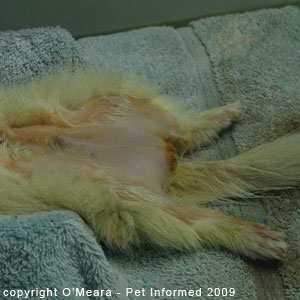
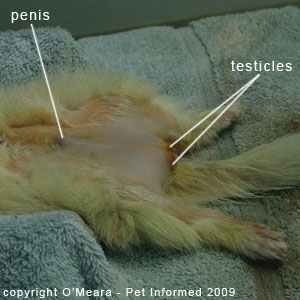
Sexing ferrets pictures: This is a different male (hob) ferret who has just been anaesthetised ready for neutering surgery. This is a side view of his belly and genital region, taken just after clipping. In this instance, the fur has been clipped away from his scrotum (i.e. the skin covering the two testicles)
and from around his penis sheath. Although it is not usually typical for the penis fur to be removed
for this surgery, the clip does show off the raised, pointed shape of the ferret penis (prepuce) quite nicely. The two round balls that are the testicles are now clearly evident within their scrotal skin covering. The testicles are marble-sized and contained within a scrotal sac located just beneath the animal's anus.
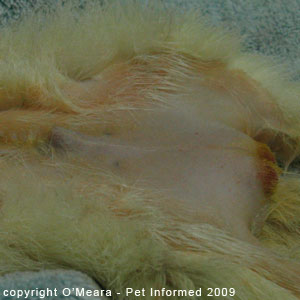
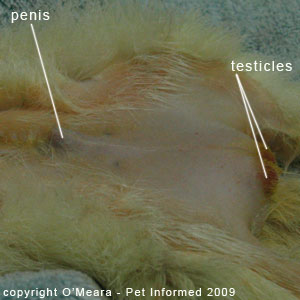
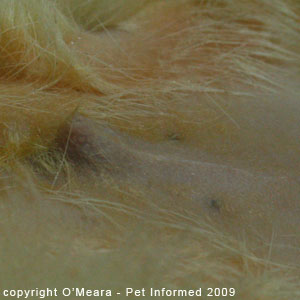
Ferret sexing photographs: This is a close-up side view of the above ferret's belly and genital region, taken just after clipping. In this instance, the fur has been clipped away from the scrotum (i.e. the skin covering the two testicles)
and from around the penis sheath. Although it is not usually typical for the penis fur to be removed
for this surgery, the clip does show off the raised, pointed shape of the ferret penis sheath (prepuce) quite nicely (in particular, look at image 3 for a close-up view of the prepuce). The two round balls that are the testicles are clearly evident within their scrotal skin covering. The testicles are marble-sized and contained within a scrotal sac located just beneath the animal's anus. The skin over the testicles appears orange in these
images because the animal's skin has been prepared for surgery using a povidone-iodine surgical solution.
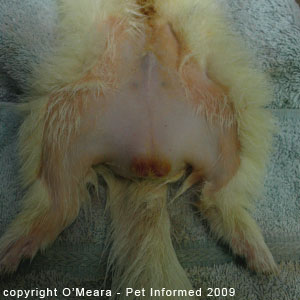
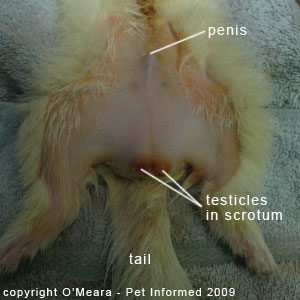
Ferret sexing pictures: This is a photo of the above male (hob) ferret taken from a different angle.
As before, the fur has been clipped away from the ferret's scrotum (i.e. the skin covering the two testicles)
and from around his penis sheath. Although it is not usually typical for the penis fur to be removed
for this surgery, the clip does show off the raised, pointed shape of the ferret's penis (prepuce) quite nicely. The two round balls that are the testicles are clearly evident within their scrotal skin covering. The testicles are marble-sized and contained within a scrotal sac located just beneath the animal's anus.
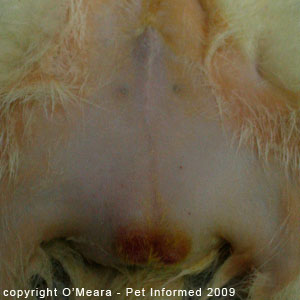
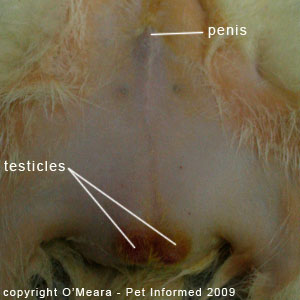

Ferret sexing images: This is a close-up magnification of the above male (hob) ferret photo. The image shows off the raised, pointed shape of the ferret's penis (prepuce) quite nicely. The two round balls that are the testicles are clearly evident within their scrotal skin covering. The testicles are marble-sized and contained within a scrotal sac located just beneath the animal's anus.
As discussed previously, the skin over the testicles appears orange in these
images because the animal's skin has been prepared for surgery using a povidone-iodine surgical solution.
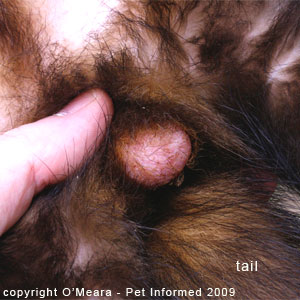
Ferret sexing cryptorchidism pictures: This ferret only has a single testicle present within its scrotal
sac. This is because the animal is a cryptorchid with a retained second testicle (testis held inside of its abdomen). For info on cryptorchidism, see our cryptorchidism page.
Ferret sexing - Female (jill) ferret pictures:
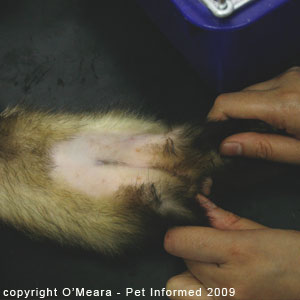
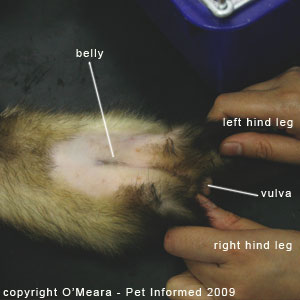
Ferret sexing images: These are photos of a female ferret. This female (jill) ferret was not anaesthetised for these photos. Although not the most compliant of patients (very wriggly), this ferret was a nice girl who was quite happy to recline on her back once there was an extra pair-of-hands available to cradle her body. A second person was needed to hold her back feet so that her belly could be clipped. The belly clipping was not performed to spay her, but to look for evidence of skin bruising (a possible side effect of her being heavily in-heat - see next section). These are close-up photos
of her clipped belly. Unlike the male's, the female ferret's belly is smooth and there are no testicles.
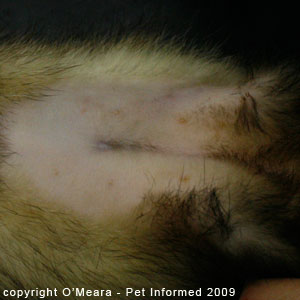
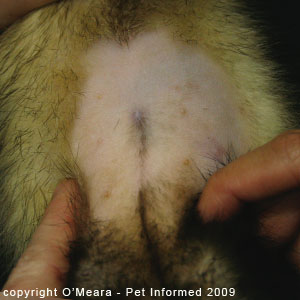
Ferret sexing photographs: These are close-up photos of the clipped belly of a female ferret.
Unlike the male's, the female ferret's belly is smooth and there are no testicles. The grayish dot in the centre
of the belly is the animal's umbilicus (belly button or navel).
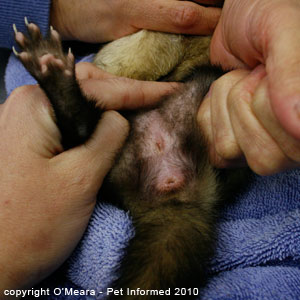
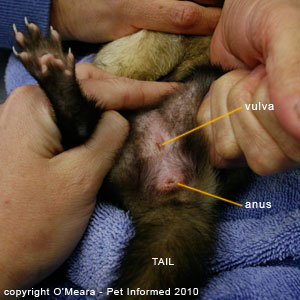
Ferret gender determination photographs: These are photos of the anus and vulva of a female ferret.
The female ferret does not have any testicles (obviously). Instead of testicles, the genital opening (vulva) of the female ferret is located just below the animal's anus. The vulva of the
female ferret appears as a vertical slit-like opening (the entrance to the vagina). If the ferret
is not in heat, as seen in the above images, the skin of the vulval opening is flat and flush with the surrounding skin.
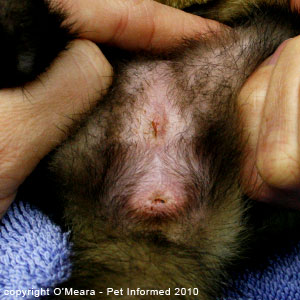
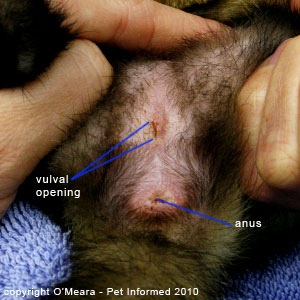
Ferret sexing pictures: These are close-up photos of the anus and vulva of a female ferret.
The female ferret does not have any testicles (obviously). Instead of testicles, the genital opening (vulva) of the female ferret is located just below the animal's anus. The vulva of the
female ferret appears as a vertical slit-like opening (the entrance to the vagina). If the ferret
is not in heat, as seen in the above images, the skin of the vulval opening is flat and flush with the surrounding skin.
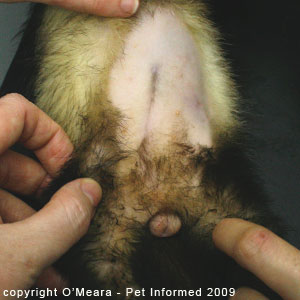
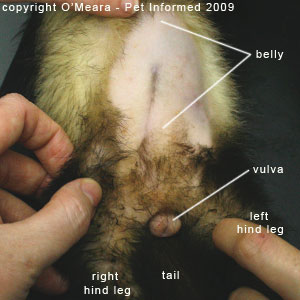
Ferret gender determination images: These are photos of the belly and vulva of a female ferret who is
in heat (in estrus). As discussed previously, the female ferret's belly is smooth with no penis or testicles.
The genital opening (vulva) of the female ferret is located just below the animal's anus. The vulva of the
female ferret appears as a vertical slit-like opening (the entrance to the vagina). If the ferret is in heat, as seen in the images above, the skin of the vulval opening becomes massively swollen, rising well above the level of the surrounding skin
(the swollen tissue looks like a giant, swollen 'donut' surrounding the vaginal opening).
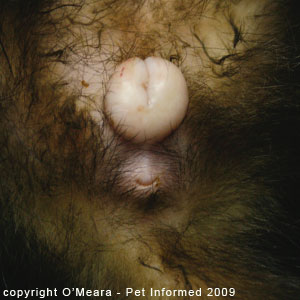
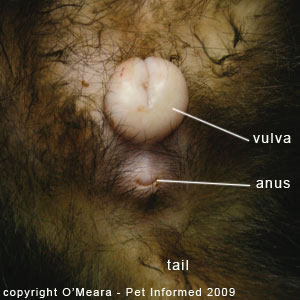
Ferret sexing pics: These are close-up photos of the anus and vulva of an in-season female ferret
(ferret in heat or in estrus). The skin of the vulval opening is massively swollen, rising well above the level of the surrounding skin (the swollen tissue looks like a giant, swollen 'donut' surrounding the vaginal opening). This is proof that the animal is in estrous (heat) and ready for mating.

3. Female ferrets who come into heat and stay in heat can die - an important health message for all ferret keepers.
 Female ferrets are induced ovulators, which means that they ovulate eggs from their ovaries only when stimulated to do so by the friction of mating (i.e. during copulation). In the absence of such mating activity (e.g. an undesexed female ferret kept as a pet without the presence of a male ferret), an entire female ferret who comes into heat will generally remain in heat for very long periods of time. You should be able to tell if your female ferret is in heat because she will have a persistently swollen and enlarged vulval opening (i.e. donut-shaped perivulval skin swelling) like the one seen in the ferret sexing image opposite.
Female ferrets are induced ovulators, which means that they ovulate eggs from their ovaries only when stimulated to do so by the friction of mating (i.e. during copulation). In the absence of such mating activity (e.g. an undesexed female ferret kept as a pet without the presence of a male ferret), an entire female ferret who comes into heat will generally remain in heat for very long periods of time. You should be able to tell if your female ferret is in heat because she will have a persistently swollen and enlarged vulval opening (i.e. donut-shaped perivulval skin swelling) like the one seen in the ferret sexing image opposite.
This persistent heat (estrus), in the absence of mating, is very dangerous for the female ferret should she be allowed to remain in heat for a prolonged period of time (i.e. should she be given no opportunity to mate and, by doing so, ovulate her eggs and go out of heat). The ripe ovarian follicle/s (the follicle/s that require the stimulation of mating before it/they can be ovulated) secrete massive amounts of estrogen. Whilst this estrogen is the essential 'female' hormone that causes the female ferret to "show the signs of heat" (e.g. swollen vulva, attraction to male ferrets) and stand to be mated by the male of the species, it is also toxic in
extreme and prolonged doses (i.e. as seen in a female ferret who is in heat for too long). Estrogen
at toxic levels causes thinning of the fur (especially in the tail-base region) and, most critically, bone marrow suppression. The estrogen stops the bone marrow from making red blood cells (which carry oxygen
around the body); white blood cells (which fight disease, cancer and infection) and platelets (which
help the blood to clot). Ferrets suffering from prolonged estrogen toxicity can suffer from
severe infections (due to white blood cell loss) and severe bruising and blood loss (from platelet loss). Untreated,
this can result in the death of the ferret.
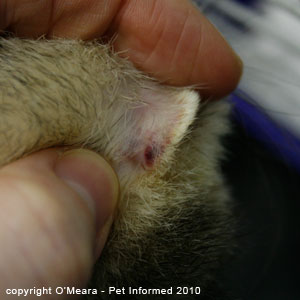
A ferret with estrogen toxicity showing the first signs of bruising (behind the right ear in this individual).
Preventing estrogen toxicity:
It is actually relatively easy to prevent estrogen toxicity in female ferrets. If you do not want your female ferret to
have babies, then you should get your vet to spay her. Properly desexed female ferrets do not suffer from
persistent estrous (persistently high estrogen levels) or from estrogen toxicity. Ferret spaying is an easy surgery to perform and no more complicated for the vet than a simple cat spay surgery is (which vets do hundreds of yearly).
If you prefer to have an entire female ferret (perhaps you are looking at breeding her some day), then there are steps you can
take to stop her staying in heat and developing estrogen toxicity.
Put her with an entire male ferret: If a female ferret comes into heat, the act of mating with an entire male
will induce her to ovulate, removing the excessive estrogen levels that can result in estrogen toxicity. The trouble
with this plan is that the female ferret will most likely become pregnant so this should only be done if
breeding the ferret (having babies) is the desired outcome.
Put her with a vasectomised male (hob) ferret: If a female ferret comes into heat, the act of mating with a male
ferret will induce her to ovulate, removing the excessive estrogen levels that can result in estrogen toxicity. A vasectomised
male is an entire male ferret who has undergone a small surgery to remove a section out of each of his vas deferens cords (the tubes that take sperm from the testicles to the urethra). Such a male still has a good libido (he will still be attracted to
and capable of mating an entire female), he just won't be able to ejaculate any sperm during copulation with the female.
Such a mating will induce the female ferret to ovulate (saving her life), but she will not be able to get pregnant.
Get your vet to induce ovulation artificially: Female ferrets who are in season can be induced to ovulate artificially
(thus saving their lives and chastities) through the administration of ovulatory medications. I have personally
used a product called hCG (human chorionic gonadotrophin) to induce-ovulate a ferret who was in heat and showing the
signs of estrogen toxicity. Within a month of the drug being given (she had 2 doses), her vulva
was no longer swollen and she was no longer in season (I then spayed her to stop the problem from occurring in the future). Should you wish to keep an entire female ferret without an entire male or a vasectomised hob
for company, you should expect to visit the vet several times a year to artificially
offset the estrogen effects of her coming into season.
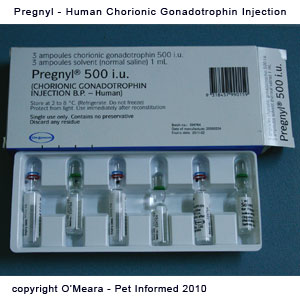
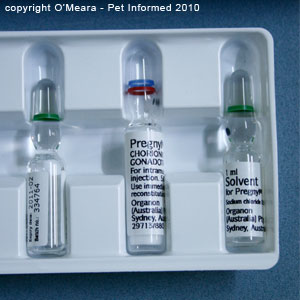
Hyperestrogenism in ferrets: Human chorionic gonadotrophin is the drug I use to induce in-heat, non-breeding
female ferrets to ovulate. I then council owners to get their female ferret pets desexed if they are not intending to
breed from them.

To go from this ferret sexing page to our homepage, click here.
To go from this sexing ferrets page to our index of animal sexing pages, click here.

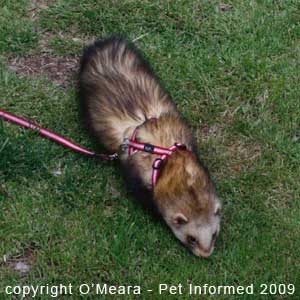 Pet Informed is not in any way affiliated with any of the companies whose products
appear in images or information contained within this ferret sexing article or our related articles. Any images or mentions, made by Pet Informed, are only used in order to illustrate certain points being made in this ferret sexing article. Pet Informed receives no commercial or reputational benefit from any companies
for mentioning their products and can not make any guarantees or claims, either positive or negative, about these companies' products, customer service or business practices. Pet Informed can not and will not take any responsibility for any death, damage, illness, injury or loss of reputation and business
or for any environmental damage that occurs should you choose to use one of the mentioned products on your pets, poultry or livestock (commercial or otherwise) or indoors or outdoors environments. Do your homework and research all veterinary products carefully before using any products on your animals or their environments.
Pet Informed is not in any way affiliated with any of the companies whose products
appear in images or information contained within this ferret sexing article or our related articles. Any images or mentions, made by Pet Informed, are only used in order to illustrate certain points being made in this ferret sexing article. Pet Informed receives no commercial or reputational benefit from any companies
for mentioning their products and can not make any guarantees or claims, either positive or negative, about these companies' products, customer service or business practices. Pet Informed can not and will not take any responsibility for any death, damage, illness, injury or loss of reputation and business
or for any environmental damage that occurs should you choose to use one of the mentioned products on your pets, poultry or livestock (commercial or otherwise) or indoors or outdoors environments. Do your homework and research all veterinary products carefully before using any products on your animals or their environments.
Pregnyl is a registered trademark of Organon (Schering-Plough).
Nutrigel is a registered trademark of Ilium.
Ferret sexing copyright July 4, 2010, Dr. O'Meara, www.pet-informed-veterinary-advice-online.com.
All ferret sexing images, both photographic and drawn, contained on this ferret sexing page are the property of Dr. O'Meara BVSc (Hon) and are protected under copyright. They can not be used or reproduced without my written permission.



 Ferrets are pretty darn easy to sex to be quite honest, even for amateur ferret keepers, making this ferret sexing page somewhat of an unnecessary addition to this website.
Still, for those of you who "just want to be sure", this page on sexing ferrets should make it easy for you to determine the gender of your ferret friends.
Ferrets are pretty darn easy to sex to be quite honest, even for amateur ferret keepers, making this ferret sexing page somewhat of an unnecessary addition to this website.
Still, for those of you who "just want to be sure", this page on sexing ferrets should make it easy for you to determine the gender of your ferret friends. 










































 Pet Informed is not in any way affiliated with any of the companies whose products
appear in images or information contained within this ferret sexing article or our related articles. Any images or mentions, made by Pet Informed, are only used in order to illustrate certain points being made in this ferret sexing article. Pet Informed receives no commercial or reputational benefit from any companies
for mentioning their products and can not make any guarantees or claims, either positive or negative, about these companies' products, customer service or business practices. Pet Informed can not and will not take any responsibility for any death, damage, illness, injury or loss of reputation and business
or for any environmental damage that occurs should you choose to use one of the mentioned products on your pets, poultry or livestock (commercial or otherwise) or indoors or outdoors environments. Do your homework and research all veterinary products carefully before using any products on your animals or their environments.
Pet Informed is not in any way affiliated with any of the companies whose products
appear in images or information contained within this ferret sexing article or our related articles. Any images or mentions, made by Pet Informed, are only used in order to illustrate certain points being made in this ferret sexing article. Pet Informed receives no commercial or reputational benefit from any companies
for mentioning their products and can not make any guarantees or claims, either positive or negative, about these companies' products, customer service or business practices. Pet Informed can not and will not take any responsibility for any death, damage, illness, injury or loss of reputation and business
or for any environmental damage that occurs should you choose to use one of the mentioned products on your pets, poultry or livestock (commercial or otherwise) or indoors or outdoors environments. Do your homework and research all veterinary products carefully before using any products on your animals or their environments.